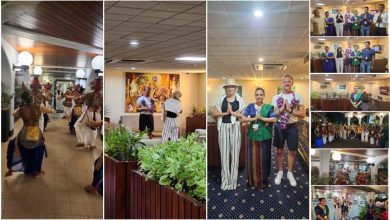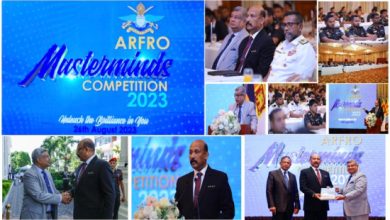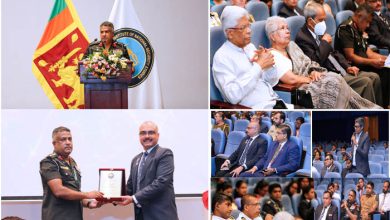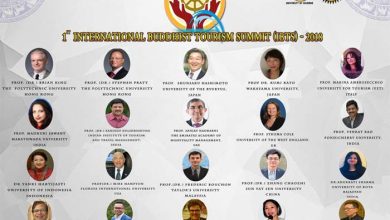Protecting endemic species at Moragahakanda and Kaluganga reservoir projects
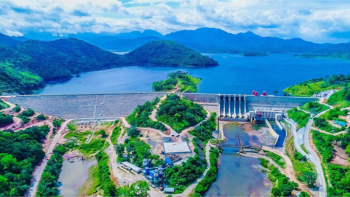
Large scale development projects always come with some negative impacts, Moragahakanda Agricultural Development Project (MADP) and the Kalu Ganga Reservoir and Agricultural Extension Projects (KR&AEP) implemented by Mahaweli Authority of Sri Lanka (MASL) is no exceptions.
MASL under the Ministry of Mahaweli Development and Environment (MMDE) initially got two biodiversity assessments done in 2008 and 2011 by engaging International Union for Conservation of Natures (IUCN) (for Moragahakanda) and EML Ltd (for Kaluganga) while the two development projects were being designed. The intended project activities of the both development were targeted to enhance the availability of water for agriculture, thereby increasing agricultural production, contribution to electricity generation, as well as improving the socio-economic status of communities and adaptation to climate change. However, the projects also have significant short and long-term environmental impacts as listed below.
Anticipated environmental impacts
Loss of habitat for terrestrial wildlife due to the establishment of the two reservoirs, and other associated developments such as resettlement areas, roads etc.;
Disruption of the movement patterns of wide ranging species, such as elephants and ungulates;
Potential increase in human-wildlife conflict, arising mainly as a result of the above two reasons, resulting in death and injury to wildlife, and simultaneously, in the loss of crops, property and life of the resettled farmers. This will prevent the achievement of desired development goals of the project;
Loss of habitat in the inundation area for stream-dwelling fish, especially those species that are endemic, threatened and restricted to this region (e.g. Dawkinsia srilankensis, Systomus martenstyni and Devario aequipinnatus); (With the recent revision of the taxonomy and phylogeny of the genus Puntius (Pethiyagoda et al., 2012) two of the target faunal species of this Project, Puntius srilankensis (the Blotched filamented barb) and Puntius martenstyni (Martenstyn’s barb), have now been placed in two different genera — Dawkinsia srilankensis and Systomus martenstyni, respectively.) and
Loss of unique habitats and migratory paths, as well as the loss of threatened and endemic species.
How those impacts have been addressed
In mitigating above negative impacts, Mahaweli Authority of Sri Lanka implemented a Biodiversity Action Plans of these two projects with the technical support from IUCN by demonstrating some pioneering work in Sri Lanka to rescue and translocate critical species of animals and rescue critical species of plants from areas which are earmarked for project activities. With the use of best scientific knowledge, criteria for prioritization of species for rescue and release were developed in order identify species that needs to be rescued from the area their habitats were expected to impact by two projects. These were done for fauna and flora separately using best science and mandated institutions for conservation.
Rescue and transplanting of Flora
With the application of the new points-based prioritisation system, it was possible to identify priority floral species more objectively, and allocate conservation efforts more efficiently and effectively, based on the criteria described above.
A total of 46 flora species, including 19 endemic species was obtained. In addition, 14 species — including four endemic species — encountered during the surveys, and deemed to be at risk, were also collected.
Plants were collected in the selected areas:Plants were documented and collected using a visual encounter method. The area targeted for construction was criss-crossed to ensure that the entire area was examined. In this way, it was possible for the team to evaluate (randomly walk across site and look carefully for target plants) an area of 1-2 km2 per day, depending on the habitat. (For example, natural forests take longer, while grasslands can be evaluated much quicker).
GPS points of priority flora were taken. Root-balling was used to excavate plants. Each plant was tagged with a numbered metal tag, and the number and species was noted against the location. Plants were wrapped in poly bags and tied up.
During the dry season these plants were transported carefully to the project plant nurseries. During the wet season, this step is omitted.
Small trees, which could not be excavated, were tagged and left for the Project Director to get them root-balled using heavy equipment.
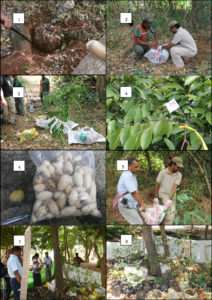
1) Root-balling a selected plant; 2) Bagging and tying of a root-balled plant; 3) A plant that is ready to be moved; 4) A plant that cannot be moved, tagged in situ for MASL staff to move; 5) Seed collection; 6) Carrying bagged plants to transport to the nursery; 7) and 8) Plant nursery. (Sampath Goonatilake @ IUCN)
The plants collected during the dry season were attended to by MASL staff in the MADP and KR&AEP plant nurseries. During the wet season, in both years of assessment, the plants kept in the nurseries were transplanted to suitable sites.
Overall, a total of 916 individuals (plants and propagules) belonging to 58 species have been transplanted from both the MADP and KR&AEP areas.
In addition, approximately 750 seeds belonging to the species Mangifera zeylanica were handed over to the Kalu Ganga Central Plant Nursery. These have been grown and about a quarter have already been planted at necessary sites by MASL officers.
The process of transplanting and the work involved in this process is illustrated in Figure 2.
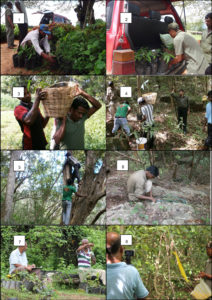
1) Plants being carried from the nursery to the vehicle; 2) Loading plants in to the vehicle; 3) Carrying plants to the selected site; 4) Preparations at the selected site; 5) Fixing epiphytic orchids on a tree 6) Planting ground loving orchids; 7) Record keeping on site 8) A tagged, transplanted plant .
Rescue and relocation of Fauna
As was done for floral species, a total of 50 faunal species, including 39 endemic species and 33 Threatened species, were included in the priority list.
In addition, another species, Dawkinsia cf. singhala, was also collected. This species closely resembles Dawkinsia singhala, but has differences in the tail fin and scale patterns, making it more similar to Dawkinsia filamentous, which is not found in Sri Lanka. Therefore, this species could be a new species. The species Dawkinsia singhala, to which it is most similar, is common and listed as being of Least Concern. However, there is no knowledge yet on whether this is a new species, what its distribution is, and what its conservation status is. Hence the conservative action of collecting this fish was used, in case subsequent studies indicate that it is a distinct and threatened.
Translocation site selection
A total of 26 sites were selected as destination sites for the translocation of fish and aquatic plants. Sites similar to those the fish species would be collected from were selected for each species. All sites were within the same river basin — the upper catchment of both reservoirs, and all selected sites were within the Knuckles Conservation Forest of the Central Highlands World Heritage Serial Property or Wasgomuwa National Park. Areas were selected avoiding areas where the threat of capture by villages was high, while sites near Forest Department premises were selected in order to ensure high security.
Fish rescue and translocation

Accompanying the IUCN field team on this visit were representatives of the Department of Wildlife Conservation and the Department of National Museum. A total of 801 individuals representing nine fish species were rescued from the MADP area and translocated to similar habitats at the upper reaches of Kambarawa Oya (Pottatawela, Puwakpitiya and the Illukkumbura area).
The rescue and translocation of fish from the KR&AEP area has a total of 1, 568 individuals, representing nine fish species from the Kalu Ganga Reservoir inundation area — covering the Kalu Ganga main dam axis to Pallegama Anicut, and Maha Oya (a tributary of Kalu Ganga, flowing through the Ranamure and Miniranketiya villages), as well as the area from the Pallegama Police Station area to the Gangahenwala village area — and translocated to similar habitats at the upper reaches of Kalu Ganga (Rambukoluwa) and downstream of main dam near Wellawela (near the Kalu Ganga Central Plant Nursery).
Overall, a total of 2,368 individuals belonging to 12 freshwater fish species were translocated from the MADP and KR&AEP areas.
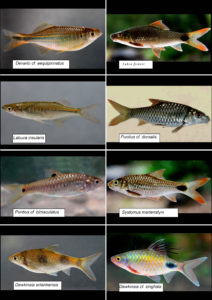
1) Devario cf. aequipinnatus (MADP and KR&AEP); 2) Labeo fisheri? (MADP); 3) Labuca insularis (MADP and KR&AEP); 4) Puntius cf. dorsalis (MADP and KR&AEP); Puntius cf. bimaculatus (MADP and KR&AEP); 6) Systomus martenstyni (MADP and KR&AEP); 7) Dawkinsia srilankensis (MADP and KR&AEP); and 8) Dawkinsia cf. singhala (MADP and KR&AEP)
Conclusion
The detailed translocation plan for Dawkinsia srilankensis and Systomus martenstyni is prepared. This plan will also be used as a guide for the other freshwater fish species proposed for translocation. MASL and other agency capacities build.
The species rescue and release work carried out in these two reservoir construction are pioneering and lessons have been incorporated as best practices into subsequent large irrigation sector projects such as Yan Oya, Upper Elahera Canal and North Western Project Canal project. Protocols developed in prioritizing species rescue and release will help better integration species conservation in development projects. MMDE is currently working on preparing a project to conserve Moragahakanda and Kaluganga reservoir watersheds for a grant from the Green Climate Fund which intends conserving the new habitats that the rescued critical species were translocated/transplanted with the overall objective of reducing climate change vulnerability of people and ecosystems of the upper watersheds of these newly constructed reservoirs.
Sampath De A Goonatilake, Sarath Ekanayake and Shamen P Vidanage of IUCN Sri Lanka Country Office.
Photographs by Sampath de A. Goonatilake, Sriyanie Miththapala and Sarath Ekanayake of IUCN


